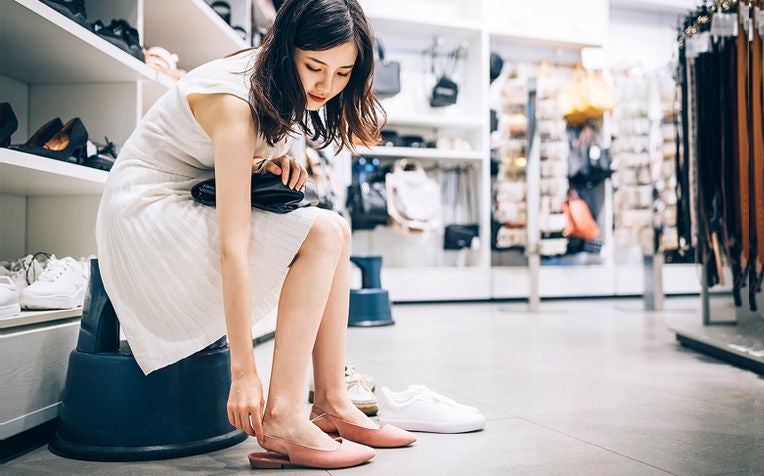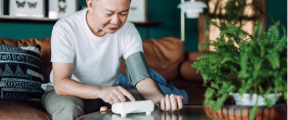
Choosing the right shoes involves trying them as well. They should feel comfortable the moment you put your feet in.
Dr Kevin Koo, Director of Foot and Ankle Service and Consultant Orthopaedic Surgeon (Department of Orthopaedic Surgery) and Principal Podiatrist Marabelle Heng from the Podiatry department, both from Singapore General Hospital (SGH), a member of the SingHealth group, offer tips on how to choose the right footwear.
Choosing footwear: Frequently asked questions
1. What should I take note of when purchasing shoes?
Currently, due to "circuit breaker", all shoe shops are closed and purchases can only be made online. However, when purchasing shoes, there are certain parts of the shoe to take note of when purchasing:
- Starting from the front of the shoe is the toebox, where the toes normally rest in. One should choose a width that can easily accommodate all the toes. It should also be long enough to have one thumb’s width between the longest toe and the end of the shoe.
- The mid-sole should not be too flexible and should provide adequate support to the arches. If the mid-sole folds easily in half, it is too soft and probably does not provide sufficient support for walking.
- The heel counter is where the heel sits. This should be firm and not buckle inwards when pressed to provide adequate stability to the heel while walking.
- Fully-covered shoes or shoes with straps provide better support.
- It is better to be able to touch, feel and try on a pair of shoes before buying. They should feel comfortable the moment you put your feet in.
Socks / stockings should be worn for hygiene purposes in our daily use, therefore it is better to wear socks/stockings when trying on shoes as well
When buying shoes for active children, choose sports shoes / sneakers for outdoors (as compared to slippers / sandals)
2. When shopping online for shoes, what should I bear in mind?
Go with the brands and the size that you have tried before and feel comfortable / confident in, because different brands / styles sizes can vary slightly.
Look for footwear types with adjustable straps / laces so there is some leeway in fitting.
Choose retailers that offer an exchange in case the size / style does not fit.
Good news: With online shopping, you are more likely to be able to order a specific size (eg. half-size) and width to suit your feet!
3. What kind of shoes should I wear for sports? E.g. running shoes / shoes for ball games / dance shoes
In addition to what was mentioned, sports or running shoes should provide additional cushioning, have a larger heel height for forward propulsion, and be more flexible at the midfoot.
There are different kinds of running shoes:
- Neutral-stability running shoes, which form the majority of running shoes, are suitable for general sports and exercise fitness such as Zumba.
- Minimalist running shoes for “barefoot” running do not provide enough support for sideway movements needed in ballgames (minimalist running believed to improve balance and proprioception). There is also insufficient heel and ankle support.
- Shoes for ball and court games. Players should wear their specific court shoes if possible as they provide good overall support for side to side movements
4. If I have a flat foot, bunion or high arch, how should I choose my shoes?
People with flatfeet should choose a shoe with a good arch support. Bunions are commonly associated with flatfeet. Hence, those with bunions should choose shoes with wider toe box and some arch support. Those with high arches should find a shoe with insoles that accommodates their arch shape. A visit to the podiatrist is sometimes useful to help with this.
5. What are the causes of flat foot, high arch and bunions?
Let’s start with bunions. A bunion is a toe that points outwards or laterally, causing a bony bump at the base of the toe, which over time can become inflamed or painful. Although there are many causes for bunions, two of the most common reasons are:
- Prolonged wearing of shoes with high heels and narrow toe boxes, as well as
- Family history
Flatfoot can be caused by tendon dysfunction or joint hyperlaxity (can be hereditary).
High arches are less common, and can be caused by certain neuromuscular conditions such as cerebral palsy, polio or stroke
6. If I have a flat foot, high arch or bunion, what do I need to take note of during daily life?
Many people with such foot conditions actually go through life without any symptoms. For these people, no treatment is needed, apart from choosing suitable shoes.
However, if symptoms begin to develop, such as pain, difficulty in wearing shoes, difficulty with walking, developing corns and callosities around the foot, then early medical attention is beneficial.
7. What problems may arise from wearing high heels?
Some of the foot conditions associated with high heels include bunions, callouses, ingrown toenails, tripping over or falling, ankle sprains, and even back pain.
Although there is no recommended ratio, heels that are higher do tend to give more problems than lower ones.
8. How about men's shoes for formal wear?
Increasingly, I am seeing more and more men with bunions in my clinic, and a large part of it, I believe, is due to the shoes they wear to work. Men’s work shoes these days are becoming more chic, and the European-designed ones tend to be more tapered in front. This can lead to overcrowding of the toes and cause bunions, among other toe deformities.
9. Are slippers bad for feet and not suitable to be worn for long distances?
Slippers do have its uses, like going to the beach or walking around the neighbourhood. It’s casual and easy to put on.
However, slippers have inadequate padding of the heels which can lead to heel pain when worn while walking long distances. It can also affect gait as the toes are recruited to grip the tongs part of the slipper and may not be able to toe off properly.
Ref: L20
Check out these other articles:
Bunion Treatment for Quicker Recovery














 Get it on Google Play
Get it on Google Play